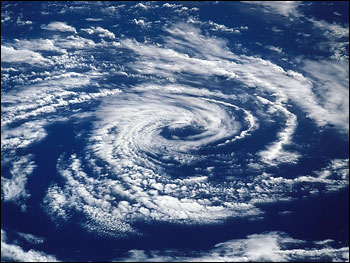| |
It is often difficult for scientists to make sense of their observations. “I’ve
developed a healthy respect for how variable the atmosphere is,” notes Thompson. “Weather systems in the
troposphere are constantly moving and mixing the air, and at the same time, chemical reactions are
changing the air’s chemical composition.”
|
|
|
| |

In studies of the atmosphere between Western Europe and Eastern North America in 1997, Thompson and her
colleagues wanted to learn how to predict ozone concentration and distribution. Using a variety of
satellite and forecast tools, they would make predictions, and then they would carry out observations to
check their predictions. “We would combine all the data we could get from various sources. We would get
real-time weather data from many sources, including the NASA Data Assimilation Office. We would get
real-time satellite data on ozone concentrations from the Total Ozone Mapping Spectrometer (TOMS) and
the Optical Transient Detector (OTD) Lightning Sensor. Then we would combine all of them to make our
best forecast of where the ozone, dust, biomass burning, and lightning would make their impact, and so
where we should direct the NASA research aircraft to make observations for us. We would forecast and
fly, analyze our observations, and then forecast and fly again to extend our understanding.” (Lightning
produces ozone.)
Major patterns of air circulation have enormous impact on ozone and its precursors. “In our work over the
South Atlantic Ocean, we would look at the satellite data and see a big blob of ozone over the ocean,”
continues Thompson. We would measure the ozone from an airplane observation, run a model, and explain
what we saw in terms of the chemistry. But why was the ozone there and not somewhere else? The reason
was that its presence is due to major air circulation patterns.” There’s an anticyclone in the South
Atlantic Ocean that brings pollution from both African and South American fires over the Atlantic. Other
African air masses travel in the opposite direction—even to Australia and the Pacific Ocean.
Other major air circulation patterns appear to carry ozone from one continent to another. Although a
complete, detailed, global picture of how natural and human activities on one continent influence the
air quality over other continents and oceans requires more research, some trends are becoming clearer.
According to modeling studies at Harvard University, background concentrations (amounts that are usually
there) of ozone in surface air over the United States range from 25 to 55 parts of ozone per billion
parts of air (ppb) and can be largely attributed to transport from outside the United States. This
amount of ozone is significant for a country where the national air quality standard is 80 ppb over 8
hours, not to be exceeded more than three times per year. The same Harvard study had implications
particularly for the western part of North America, which receives more pollution from Asia than the
eastern part does. In fact, if people in North America succeeded in reducing their emissions of nitrogen
oxides and hydrocarbons (ozone precursors) by 25 percent, the expected tripling of Asian emissions by
2010 could more than offset that North American effort.
Because air currents move both east and west over the Atlantic Ocean, Europe and North America influence
each others’ air quality. One study based on models in combination with data from ozonesondes
(ozone-measuring instruments often flown on balloons) found that ozone produced in the lower troposphere
over North America contributes an average of about 5 ppb to surface ozone at the study location in
Ireland, but sometimes as much as 10-15 ppb. Other intercontinental and inter-regional air movements
carry pollution from one part of the Earth to another. For example, sometimes circulation in the
troposphere can funnel northern mid-latitude pollution (including pollution from eastern Asia) over the
Middle East. Pollution from Indonesian fires during 1997 reached India. Air pollution from China
sometimes drifts directly over Japan. The point is that some countries (such as Japan) cannot have clean
air until other countries (such as China) do.
 The Key Role of Modeling The Key Role of Modeling
 Highways of a Global Traveler Highways of a Global Traveler
|
|
The ever-changing and complex nature of the lower atmosphere (troposphere) makes it
difficult to trace the chemical reactions that produce ozone. (Shuttle Photograph STS108-723-081 courtesy
NASA Johnson Space Center)
|

